Banker's Digest
2023.06
Chinese banks' profit suffering from shrinking net interest margin notwithstanding the reopening

The profitability of Chinese banks depends on both economic factors and government priorities. The latter has been decisive as policies tend to increase the procyclicality of banks’ profits in exchange for support to the economy in difficult times. However, a reversal of policies can also lower bank profits even when the economy is doing well. As such, China’s difficult economic situation in the past few years has led to flatter profit growth for banks on average, but still better than one could imagine given the poor state of the economy. Now, instead, policy countercyclicality means that banks are not going to benefit from the recovery as much as expected. To make matters more complicated, however, the recovery is also waning and policy rates are being cut by the People’s Bank of China. Profitability is not only facing cyclical, but also secular drivers.There is no doubt that Chinese banks are important not only for the economy, but also for policy transmission. They are the largest providers of credit, and are either state-owned or partially locally owned, which means that they are the most important channel for the government to transmit its policies, whether monetary or fiscal.As to the way forward, assuming loan provision is steady, four key factors affect profitability: asset growth, net interest income, fees and commissions, as well as investment income. To mitigate the pandemic’s negative impact, China has relaxed its monetary policy. Banks’ fast asset growth has acted as a stabilizer of their profits despite the challenges in asset quality. As the economy reopens, asset growth will likely to accelerate further in 2023. The weaker-than-expected cyclical rebound also means that room for monetary policy tightening is not there, especially given the still very hawkish Fed. All in all, Chinese banks should be facing a structural trend of lower net interest margin and return on assets, which also parallels their potential growth.First, asset growth has been decelerating since 2021 even as interest rates having been coming down. The sharpest fall came from mortgages, since the People's Bank of China lowered the 5-year loan prime rate by 30 bps last year and it has just lowered it again another 10 basis points given the very poor economic data for last May. Banks also lowered corporate loan interest rates but on a relatively minor scale. Bill rates have increased in the first quarter of this year, mainly due to financial institutions’ active adjustment to avoid credit demand overdraft, which is likely short-lived. In contrast, banks’ funding costs have barely changed. The divergence in loan and deposit rates is behind the shrinkage of net interest margin.Against this worrisome backdrop, which has been going on for quite a few years, Chinese banks have tried to increase non-interest income, but it has not really worked. If anything, the contribution of non-fee income to profits has shrunk in the past few years.In fact, as household and business sentiment was conservative, deposit growth outpaced loan growth, especially through more costly time deposits. China was on a trajectory of rising loan-to-deposit ratios between 2017 and 2019 as banks moved shadow banking activities back onto the balance sheet. However, the multiple episodes of COVID-related lockdowns and the regulatory tightening on real estate have harmed consumer confidence, at least in the short run, leading to a spike in deposit growth. Time deposits have been growing quickly in the last 12 months, and households drive most deposit growth as they lack the incentives to consume and invest, which explains the further easing by the PBoC in the last few days.Regarding fees and commissions, settlement and clearing is the only income type with growth due to the growth in cross-border RMB settlements. However, this pool of income is not big enough to offset the pressure in other areas. Furthermore, due to regulatory changes, weaker consumption and investment sentiment, there is still a significant revenue decline in bank cards, advisory and wealth management and shadow banking businesses. Another buffer is investment income as banks are the biggest buyers of local government bonds.All in all, the investment sentiment is still weaker than many years ago, which is bad news for demand for loans but even for wealth management products (WMPs), especially after the regulatory change discouraging guaranteed products. Regarding bank cards, the reason is simple. It is evident that consumers are less willing to spend, due in part to stagnant income growth and worries about job security. The decline in advisory fee income could be related to a general fall in demand for financial services as well as tightening regulations, which are designed to counter overstated charges for advisory fees used to cover up improper benefits provided to corporates, such as extra credit.



